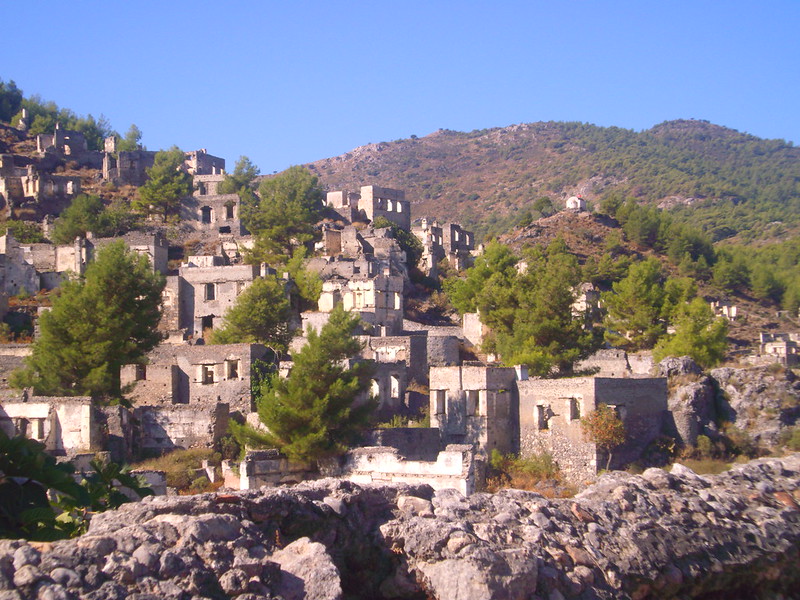Kayaköy is an abandoned village located 8km south of Fethiye, in southwest Turkey's old Lycia Province. The town's name was originally in Ancient Greek was Livissi. It changed to Koine Greek during the Roman period. In the Middle Ages, it became Byzantine Greek and then Modern Greek before its final evacuation in 1923.
 |
| Ghost city Turkey |
Kayakoy Turkey
Kayakoy Turkey ghost town is one of the abandoned places in Turkey
The region's inhabitants had converted to Christianity during the Greco-Turkish War of 1919-1922. Following the Treaty of Lausanne, 1923, the Greek Orthodox residents of the town were exiled from Kayakoy. The Protocol on the Population Exchange between Turkey and Greece was included in that treaty. It prohibited the return of any previous Greek Orthodox refugees to Turkey (including those who had fled Kayakoy) and required that any Orthodox Christian citizens remaining in Turkey move for Greece (except for those living in Istanbul).
The treaty required that all Greek Muslims permanently flee Greece to Turkey. This was except for Muslims who live in Greek Thrace. Exiled Muslims from Greece found Livissi Kayakoy inhospitable, and they quickly decamped to leave the hillside village. This ghost town is now preserved as a museum. It consists of hundreds if not all standing Greek-style homes and churches that cover a small mountainside. They serve as a stop for tourists visiting Fethiye or Oludeniz.
First Image / Source
 |
| Kayakoy Turkey |
Image / Source
Livissi/ Kayakoy village
Fethiye to Kayako — Livissi was probably where Byzantine Gemiler Island's inhabitants fled to escape pirates. After nearby Fethiye, also known as Makri, was destroyed by an 1856 earthquake and a major fire of 1885, it experienced a revival. In the village and on the plain, more than 20 churches and chapels were constructed (Taxiarhes, the Upper' and 'Panayia Pyrgiotissa, the lower' churches - St. Anna and St. George, respectively). In Kayakoy history many of these structures are still in ruinous and semi-ruinous condition. According to Greek and Ottoman sources, the village population was more than 6.000.
Kayakoy residents were persecuted along with Greeks from nearby Makri (Fethiye) as part of a wider campaign against all Ottoman Greeks (cf. Armenian genocide Makri was the first place where persecutions began in this area in 1914. Many Kayakoy families were later deported to Denizli (around 220km away) by Turkish authorities in 1916. They were subject to a variety of atrocities, tortures, and even death.
In 1917 and 1918, two more exile periods followed. Families were forced to march for fifteen days from Denizli to Acipayam in 1917. This was a group of elderly, women and children who had not left the area. The roads were littered with the bodies of children and elderly who had succumbed to hunger or fatigue during that death march in Kayakoy ghost town.
Turkey ghost village was almost empty of its inhabitants at the beginning of the Greco-Turkish War (1919-1922). The few remaining Greeks from Kayakoy or Makri had to leave their homes to sail to Greece after the war ended in September 1922. Some of them established the refugee settlement Nea Makri (New Makri), outside of Athens. Many of the empty buildings in the town were destroyed by the 1957 Fethiye earthquake.
 |
| Turkey ghost |
Image / Source
Ghost city turkey is now a museum. It also serves as a historical monument. Nearly 500 houses are still in ruins. They are now under the protection and control of the Turkish government. A private museum traces the history of the area. A fountain, which dates back to the 17th century, is located in the middle of the village.
Kayakoy has been claimed by some sources to have been adopted as a World Friendship and Peace Village by UNESCO. This is untrue, and most likely a rumor spread by a local tourism council.
The Turkish government announced plans for the development of the village on 9 September 2014. It will offer a 49-year lease to Kayakoy that will "partially Open Kayakoy's Archeological Site to Construction" and anticipates "construction of a Hotel, as well as tourist amenities that will cover one-third the village."
 |
| Ghost world wiki |
Image / Source
 |
| Kayakoy |
Image / Source
 |
| Kayakoy ghost town |
Image / Source
 |
| Kayakoy turkey ghost town |
Image / Source
 |
| The ghosts of Turkey's past |
Image / Source
 |
| An abandoned church, Kaya Turkey |
Image / Source
 |
| Livissi |
Image / Source
Kayakoy Turkey Map
Kayaköy, 48300 Fethiye/Muğla, Turkey
Abandoned ghost town - Kayaköy Turkey | Video
 |
| Kayakoy history |
Image / Source
Source | Wikipedia

No comments:
Post a Comment